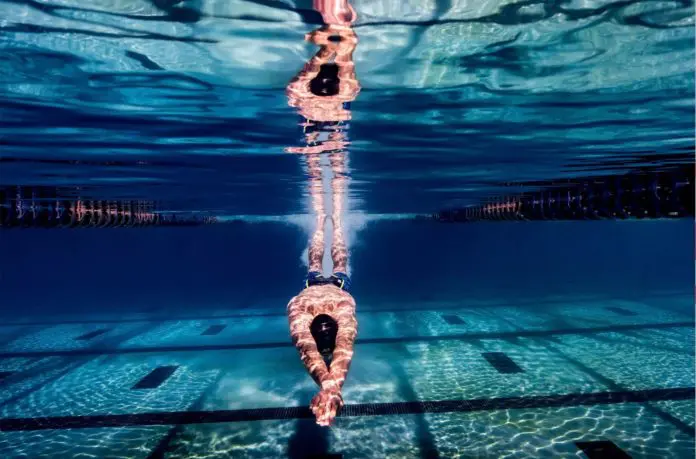Online education and training has become all but ubiquitous in this era of digital transformation, impacting most industries, and even beginning to extend to sports and other physical activities.
Scuba diving has slowly begun to move in this direction, witness the fact that most agencies now offer e-learning options for coursework, and of course a plethora of YouTube videos and video channels like GUE.TV, which features things like skill demonstrations and drills. Freediving is also slowly going digitally with e-learning, and there’s a growing number of online workshops, for example, those offered by Immersion Freediving, Florida.
However, it is swimming and swim coaching, the foundational roots of water sports that are arguably pushing the envelope of what can be done online.
At the vanguard of these efforts is 28-year old head technique coach at Ritter Sports Performance, Abbie Fish, who is elevating traditional on-deck coaching to the cloud, bringing online swimming technique coaching to pool and open water swimmers, triathletes, master athletes and their coaches. “We’re hoping to become the go-to resource for swimming,” she said. Don’t let her age fool you; she knows of what she speaks.
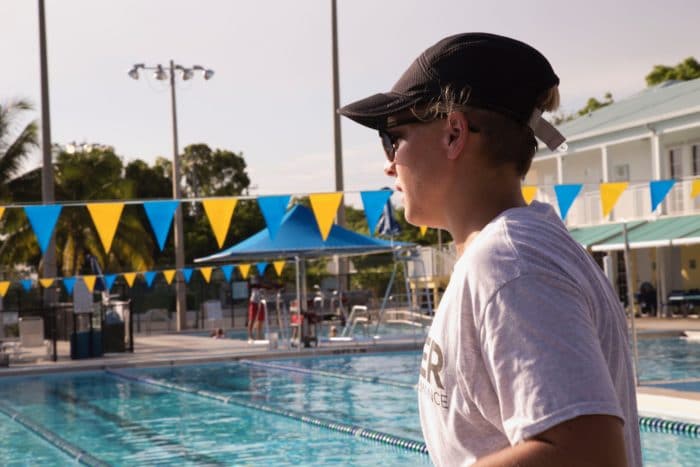
Fish, who has been coaching for 10 years, began competitive swimming at age five and hasn’t ventured far from a pool ever since. She was on the swim team at the University of Georgia where she earned her B.S. and M.S. in Exercise and Sports Science. She also qualified in six events for the 2008 Olympic trials though didn’t make the finals, which serendipitously led her to coaching. “I realized that I got as much satisfaction and excitement helping others to achieve their swim goals as I did my own. From there it was an easy transition to get into coaching because I realized I could actually help people make their goals a reality,” she told me.
In 2014, Fish interned at the high-performance department at USA Swimming’s Olympic Training Center where she helped elite swimmers strengthen their technique, and boosted her knowledge of stroke mechanics and analyzing swimming techniques using a variety of digital tools. From there, she became the youngest coach at the storied Race Club, Islamorada, FL again focusing on technique. “You can train very hard, but at the end of the day it’s technique i.e. maxing the efficiency of your stroke that really counts,” she explained. “Swimming technique is my jam!”
Intrigued by the potential of reaching more swim aficionados through the Internet, the geeky, data-driven swimmer turned coach teamed up with swim and strength coach Chris Ritter, founder of Ritter Sports Performance (not to be confused with the Ritter SPORT chocolate company) in 2016 and began helping Ritter expand their online platform. In addition to technique, the company offers strength training (C. Ritter’s specialty), and swim coach development.
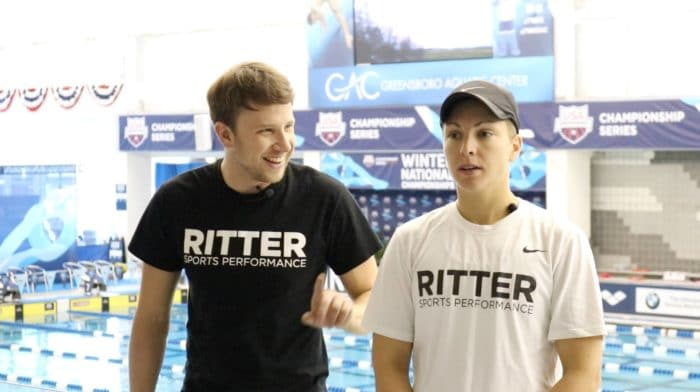
We recently caught up with Fish, who in addition to her work for Ritter manages a local swim club and pool in Islamorada, Florida. Here is what she had to say.
You’ve held some prestigious coaching assignments. You coached at the Nashville Aquatic Club, The Athens Bulldogs Swim Club, the Lakeside Seahawks. What made you decide to take your coaching online?
The one thing that I was struggling with my traditional coaching jobs was the fact I love connecting with people and forming relationships. I definitely don’t want to “diminish” local coaches – the ones I had really did a great job for me. I just felt in my heart I could increase the number of swimmers I touched to a larger degree if I offered my services worldwide. I still keep in touch with most of the 30 or so kids I had at all these other jobs but I just felt like I could really live out my life mission if I gave online coaching a go.
The one position I had at The Race Club, Islamorada, FL was the first stint I had that exposed me to the online realm – as 50% of the coaching I did was through the internet and the other 50% was in person. It was the first gig that showed me I didn’t have to be geographically limited and could take it on a larger scale. From there I ended up partnering with Ritter and went 100% online. Now, I work with swimmers all around the world and I absolutely love my job.
At first blush, online coaching might seem counterintuitive. Of course, people do academic learning online and universities are moving online, but when you talk about a physical activity like swimming or freediving, scuba diving or other physical activities, how well can learning take place on an online platform?
It’s definitely where education is going. There are more and more online universities, there are more and more online physical trainers. I think that people are realizing that you don’t need to be necessarily in the right location to be successful.
I was just over in Australia for a coaching development stint and it was really interesting because they have changed their model on how swim clubs receive funding. They used to be funded by the Australian government, but now that money is allocated to individual states to decide who, when, and how much they give to each club. As a result, the only clubs that are receiving large amounts of funding are clubs located near the big cities, where they have large numbers of swimmers. But, what one of their coaches pointed out to me was they are totally missing the rural part of their population, that used to be good at swimming and generated Olympians.
So the biggest thing from an online learning perspective is that you can give interested swimmers an opportunity to work with some of the best coaches out there, no matter where they were born, where they live, or what is going on with their family situation. I think that raises the level of competition all around and allows anyone to be in a situation to become a fast swimmer.
Swimmers can get access to coaches. Are there other benefits to getting coached online?
Absolutely. The other great thing about online platforms is that you can get one-on-one direction and coaching. People generally train in a “team” environment and for all the technical stuff—that is normally generalized too.
When you are being trained online by one specific coach, all the technique recommendations and prescriptions are based specifically on what YOU need—it’s no more drills for the entire group where only 60-70% benefit anyways. For example, the swimmers I coach through RITTER get a specific lesson plan to improve their strokes, that they implement in their daily practices.
So online learning can actually be a great supplemental tool for your local primary coaches. It can help you understand what you need to do better, without putting more pressure on your day-to-day coach to prescribe 30 individual training plans for his/her entire team. Plus, if we make you faster—your primary coach will see and receive those direct benefits as well.
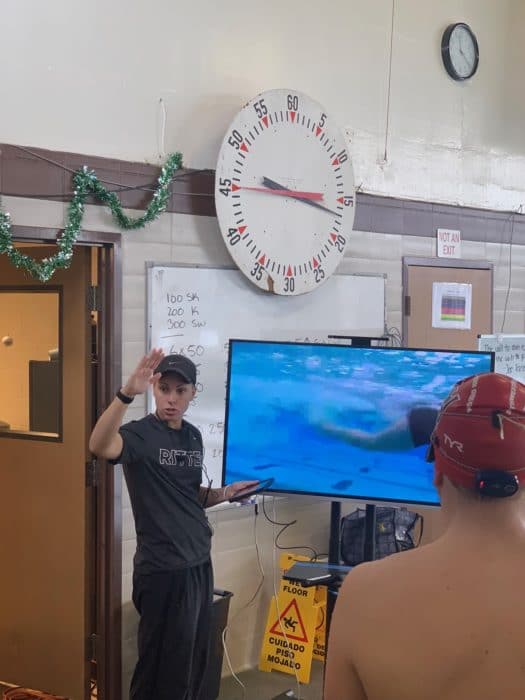
Obviously, if you’re a coach on a pool deck, you see the swimmers, give them an assignment or set to do and then watch them perform. How does that work with online coaching? How do you evaluate your trainees?
There are definitely pros and cons to in-person and online coaching. For me, the basics start with video analysis of my clients’ swimming technique. On the RITTER site, our clients can upload videos of their swimming, and we can get a very good sense of what they are doing and how they are performing, especially if they take underwater footage as well.
It is harder to train people from a distance; there is definitely something to be said about having your eyes on a person every day, for every single practice. However, from a stroke technique perspective, and for me being a biomechanist, I don’t need to see my swimmers every single day. The reality is when I work with somebody, they will have a lot of things they take from the feedback that they need to go home and work on, and most of these changes don’t happen overnight. They said it takes about six weeks to formulate a new habit, so if I get a check-in from my swimmer every two weeks, I have a very good sense on the direction they are going and the tenacity they have towards implementing those changes.
I understand that you use video software to analyze swimmers’ strokes?
Yeah, I primarily use Dartfish. I would say it’s still the BMW of swimming software. Dartfish has been around for a really long time and for the most part—it’s still pretty solid and delivers. But, it’s not the only program I use. There are also other programs out there that are less intricate, but they still get the job done. It just depends on who I am working with and what we are trying to look at—to either generate data, annotation, voiceover or a mixture of all 3 for their feedback.
What kinds of insight can those programs give you?
A lot of different things. First, it can give you eyes in areas that a coach on the deck is not able to see. On top of that, you can slow it down, you can reverse it, you can mirror it against somebody else whose maybe in your group squad age range or Olympians. It really gives you a chance to look at a stroke in minute detail. The video can be as quick as 60 frames a second, so you can break-down how the swimmer is moving their body to increments of 1/60 of a second–which you could never do on land.
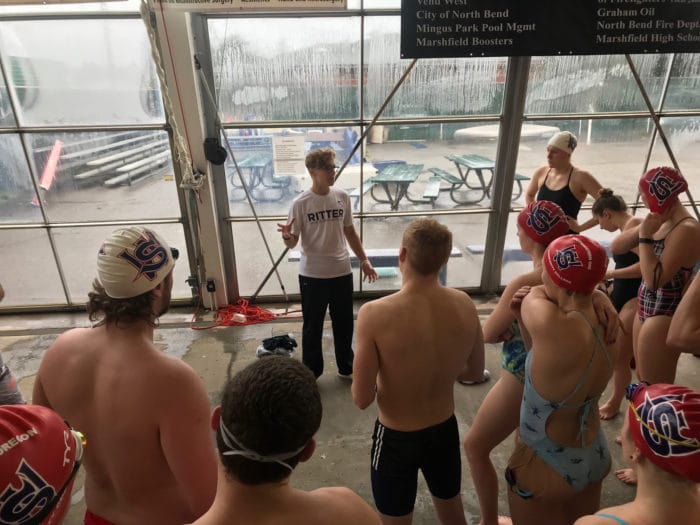
I see that RITTER has made some changes in its focus recently. What is that about?
We recently launched our brand-new membership site called the RITTER Hive, which is a complete revamp of our platform. Basically, it brings together everything we’ve been putting out over the past few years into one main site.
Our goal has always been to be the best continuing education resource for swimmers and coaches, and we still are that. However, we realized that there is really an underserved market of coaches out there, that are looking to learn more—so we are focusing our resources to serve that need there.
One of my favorite quotes is, “Training is science, but coaching is art.” We’re hoping to advance the state of the art.
Do coaches need coaching?
Most coaches are working hours outside of the hours’ normal people work. That puts coaches on deck for early morning workouts (before 9 AM), and on-deck late afternoon into the evening after school has commenced and offices have closed—really, 3 pm – 9 or 10 pm at night. In between those on-deck hours, coaches have administrative work to complete, meet entries, website/email outreach, and parent meets to attend to as well.
On top of those day-to-day responsibilities, coaches travel on weekends to swim meets and for collegiate recruiting (if you’re in collegiate coach). The reality is, as a coach — you really don’t have much time to devote to your continuing education. I just met up with some coaching buddies last weekend, who have worked 8 out of their 9 past weekends for swim meets and training through the Holidays and New Year.
Our goal is to bring digital content to coaches, so they can continue to learn wherever they are—at whatever time of day. So whether it’s a short 15-minute video on a Tuesday, or a few hours on a Sunday afternoon—our coaches have the ability to learn from others on THEIR time when it’s convenient for them, and not feel compelled to skip practices for clinics or travel more than they already do.
How does that actually work?
The last two years we’ve had three main verticals: stroke technique, strength training, and swim coaching, and each area was doing its own thing. With the Hive, we have combined all that content. Basically, every month we dissect a certain style of swim technique. In January, our first month–we focused on the freestyle kick and we provided all the fundamental things, you need to know in order to actually improve your kick. We came at it from all angles—technique, strength/dryland training, and also brought sets/workouts from a world-class coach who has developed swimmers on this technique. That’s the
kicker with the Hive. We bring in these expert coaches—so you have the chance to learn from some of the BEST of the BEST, and complete their workouts.
What would you say are the biggest challenges that say, Masters swimmers (post-college swimmers) face? Is there a common theme in improving their swimming?
One thing that I think some coaches tend to forget, is how important the fundamentals are. Even though most Masters swimmers are older, many of them are still learning how to swim. They need to work on their body balance, streamlining off every wall, improving their dolphin kick, those sorts of things. There are definitely Masters swimmers that have an extensive swimming background, but the majority do not. I feel like most inexperienced Masters coaches coach to their top level, and the reality is they have a pool with swimmers ranging from levels A to Z – really like the beginner levels of an age group team.
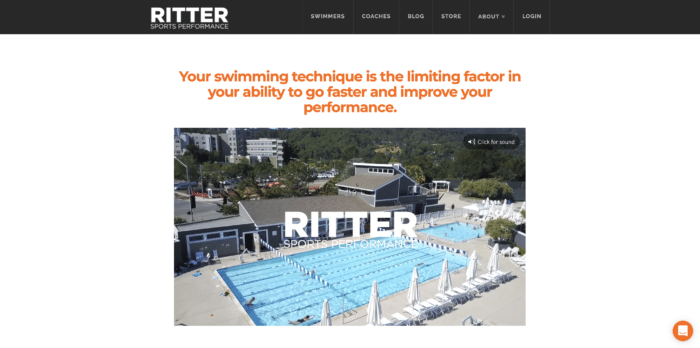
My local team has a few swimmers that swam in college and or have competed, but I would say the majority are triathletes, runners and bikers hoping to improve their swimming.
That’s good if they have a running or cycling background because that means that they are athletic. But even with that athletic background—putting someone into a pool (which is a resistance environment) and then changing their body position from vertical to horizontal—is a HUGE change.
You can try and mimic the resistance environment in a weight room or training facility—but at the end of the day, there really is NO direct replacement for time spent in the pool.
Resistive environment due to the density of the water? Is that why technique is so important in swimming?
Yeah. The drag coefficient forces in water are astronomically higher than anything you do in the air. Water is about 800 times denser than air which means that your drag related forces are going to be sky high. The reality is that smaller details play a bigger role. If you’re a runner, and you change the angle of your hands drawing forward, will it make you a faster runner? Possibly. But if you’re a swimmer and you streamline how your hands move through water, it could make you a much faster swimmer.
That’s a good one. Do you see many common themes in terms of technique and or technical issues that swimmers need to work on?
I look at technique from the inside out. First, I look at the body. The core, the hips, the shoulders, and then from there, go out to the limbs. When I first look at a swimmer in the pool or on video, the last thing I would ever say is, “Hey, your thumb entry on your right side of freestyle stroke needs to be changed.”
If we scale out that feedback, changing their thumb entry is may not fix any of the other parts of their stroke–because it’s one of the furthest points away from the body. Secondly, it’s a super minute thing. The reality is that changing thumb entry will be far less significant, compared to say changing one’s body alignment, which is a common issue: body alignment, undulation, and rotation. That’s usually where I see most issues and so that’s where I usually start. From a stroke mechanics perspective, if we can fix that, people see a huge difference in their swimming, and it’ll have a ripple effect on other issues in their stroke—which you may not even need to address!
The reason I love stroke technique is its’ basically a puzzle, and you are trying to find the next best piece to move forward with the puzzle. Obviously, as a biomechanist, all pieces are on the table, but really finding the right one that will help the others fall into place, is my job.
How about turns? I was told they had a potentially huge impact on swim times.
I think turns are way underutilized. Of course, there are a lot of triathletes that don’t care about pool training, but there are many Masters swimmers who treat the wall as a kind of a rest stop. The reality is that your second highest swimming speed occurs off every single wall. Typically, swimmers can hit up to 15 meters per second off the blocks, which is faster than people can run, but they can hit up to seven meters per second off the wall with a good streamline and a few dolphin or flutter kicks. To put that into perspective, most people only swim around two to three meters per second – so why not use your walls more?
Wow. That’s huge.
Yup. You can make a big difference in utilizing turns, especially for people who are really competitive. If you want to make a drastic difference in your swimming, look at your body alignment and position first and then, look into the transition points of your race.
Has there been a lot of new science about swimming, say over the last five years?
I would say that there is definitely more and more scientific, data-driven work being done overseas than here in the USA. Australia, for example, has these institutes for swimming where they are constantly testing and looking for the next best way to swim faster. England has a ton of training centers as well.
Has any of this research made a difference in swimming?
The strength and conditioning component to swimming has been on the rise over the last decade, and there’s more and more research coming out on that supports the argument that general athleticism makes for faster swimmers. There’s still a large distinction between people who consider themselves swimmers and people who consider themselves athletes. And the more, as coaches, we consider swimmers as athletes, the faster our swimmers will be.
You’ve mentioned data-driven coaching. How does that relate to swimming? Can you put the two together for me? What is data-driven about swimming or swim coaching?
I like to look at swimming kind of like a math equation. Most swimmers have time, or specific output or other metrics they are shooting for, and from there — I like to back-up and focus on the other half of the equation, on the other side of the equal sign, to help them to get there.
Swimming can be super simplified from a data perspective to splits, overall time, stroke count, stroke rates, time underwater, and/or # of dolphin kicks — I view my job as being able to communicate how those numbers will help someone get to where they want to go and make the numbers on the outcome side of the equal sign possible.

